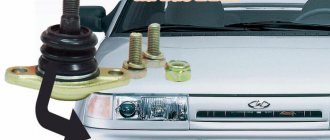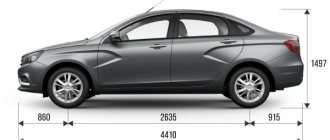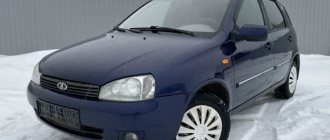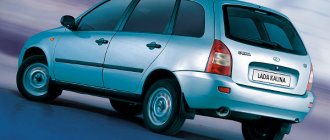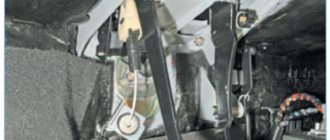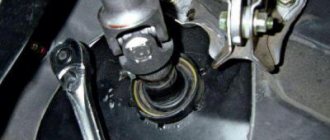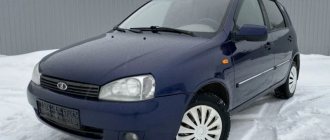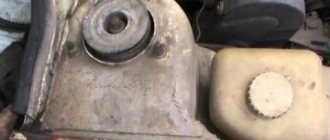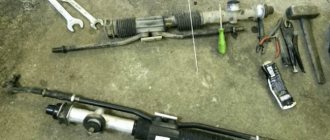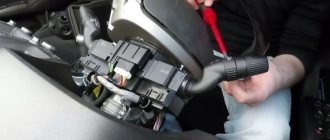When malfunctions occur in the front suspension of a car, one of the first measures that its owner should take is check the support bearing, located between the support and the upper spring cup. To do this, you will need to grab the “cup” of the rack with your hand (put your hand on the support) and rock the car. Constant, sharply changing loads, including shock loads in combination with abrasive dust particles, contribute to the wear of the components of the support strut bearing and ultimately completely disable it. As a result, it begins to play, knock, squeak or squeak, and the shock absorber rod deviates from its axis.
Diagram of the support bearing operation
Such problems with its operation can lead to more serious consequences in the car’s suspension. Since wear of the support bearing will lead to a violation of the wheel alignment angles, and consequently, a deterioration in the car’s handling and accelerated tire wear. How to check and which manufacturer of thrust bearings to give preference to when replacing - we will tell you about all this in more detail.
How to check the serviceability of the front strut support bearing
Hello, dear friends! Let me call you exactly that. Today we have to discuss a fairly relevant topic for almost any car and its owner. We'll talk about the front strut support bearing.
Alas, the quality of our roads leaves much to be desired. Sometimes, when I travel outside the city center or into the suburbs, I am amazed at how anyone can drive there without visiting a service station every week.
The condition of the roads largely determines the need to change the support bearing quite often. The part is not the most expensive, but you will have to tinker with it if it fails.
What supports to put on Kalina
The choice depends on you and your budget. Today, manufacturers offer us a large selection of support bearings from 300 rubles to 3000 rubles. Which ones to install is up to you to decide. You can purchase factory supports, or you can choose an option from another manufacturer. The most popular supports are:
- Rack support FENOX price from 500 rub.
- Rack support Balakovo price from 350 rub.
- Rack support TRACK price from 800 rub.
- Rack support BZAK price from 600 rub.
- ASOMI supports, Tolyatti price from 3000 set
- Supports SS-20 Togliatti price from 3500 rubles set
Some car enthusiasts, for the so-called suspension tuning, install ASOMI or SS20 supports.
Getting to know the journal bearing
To begin with, I suggest the simplest thing - getting to know the device. The support bearing (OS) is necessary to create a movable connection between the machine body and the shock absorber. On VAZ 2110, 2114 cars, models such as Grant, Kalina, Priora, as well as on all kinds of foreign cars Mitsubishi, Volkswagen, Fiat or Toyota, for example, the location of the OP is approximately the same - the upper part of the pillar. Install the bearing between the support and the upper cup (or cup, anyone) of the shock absorber spring.
If we look at it purely from a design point of view, then we have a variation of rolling bearings. But OP differs from them in the large thickness of the outer ring. The rolling bodies are cylindrical rollers. They are placed perpendicularly and separated from each other. Due to this design, the unit can take on loads from different sides.
The task of the OP is to provide the shock absorbers with the ability to rotate freely in the supports. In any car, be it a Ford Focus or Mondeo, Chevrolet Lanos, Cruze, Lacetti, Aveo, Daewoo Nexia, Hyundai Accent or Skoda Octavia, the OP will always be slightly higher than the front spring. The shock absorber rod will pass through the central cavity of the element. Shock absorber bodies are always mounted to the body where the OP is located. As a result, two types of loads act on the support - axial and radial.
Before you replace and buy a new element to replace the old OP, you need to understand their types. This is where we will start. Do you agree? Then go ahead.
Types of OP
It’s difficult to say for sure which OP is better to buy. Much depends on the specific car. How to check if OP is good or not? First, ask how much the bearings cost. Good parts cannot be cheap. But it’s not worth chasing the most expensive models if you have a budget car. Try to choose the golden mean.
Besides the fact that you need to look at the manufacturer, the specific type of bearing will be an important consideration. There are several varieties of this device.
- OP having a built-in inner or outer ring. For installation, mounting holes on the housing are used, so there is no need for clamping flanges.
- OP, in which the inner ring is separated. Structurally, the outer ring is connected to the body. It is important to take such devices in cases where you need to achieve the most accurate rotation of the outer ring.
- OP having a detachable outer ring. This is the opposite version of the previous bearing. Accordingly, they are taken if necessary to obtain precise rotation of the internal element.
- Single split bearings. The outer ring on such OPs is divided into one precisely. With their help, high rigidity values are achieved.
Sooner or later the fault will manifest itself. This mainly occurs due to dirt, sand and moisture getting into the unit. On average, the first signs of a malfunction appear after about 50-75 thousand kilometers. Replacement is recommended every 100 thousand kilometers.
Steering cardan
If, when turning the steering wheel, you hear a knocking sound from the steering column, then the steering wheel shaft driveshaft is most likely to blame. Very often UAZ owners face this problem. A malfunction occurs due to an increase in the gap in the spline joint. On VAZs, a knocking sound from the steering column occurs due to a broken universal joint. It can be heard both while driving and when turning the steering wheel back and forth in place.
Many owners of domestic front-wheel drive VAZs - “Kalinas”, “Priors”, “Grants” - are faced with the fact that over time the crosspiece in the driveshaft begins to creak. Its diagnosis is carried out according to the procedure described above. If play and creaking are detected, the car owner can choose one of two options. The first is to buy a new cardan, the second is to try to repair the installed one.
Moreover, they are repaired not because of the high price, but because of a large number of defective new cardan shafts. In particular, we are talking about the fact that the cardan can “bite”. This is caused by the fact that its half with splines moves with jamming, and jerks are already felt in the new part. Accordingly, when purchasing a new crosspiece, you need to make sure that it moves freely in all directions. It often happens that in a fork with splines, the bearings are initially skewed due to misalignment of the holes. Therefore, it is up to the car owner to decide whether to buy a new cardan or not.
Another way out of the situation is to replace the existing needle bearings in the cardan crosspiece with caprolactane bushings. This option is supported by the fact that many taxi drivers who own VAZs, due to the fact that they have to turn the steering wheel a lot, do exactly this.
This option implies the complexity of repair work. As for dismantling, they usually use 13mm wrenches and a flat-head screwdriver.
On the Internet you can find many conflicting reviews about various cardan shafts and bushings. For VAZ “Kalina”, “Priora”, “Granta” cars, crosspieces of the “CC20” and “TAYA” brands are often installed, or a more expensive option is Japanese spare parts Toyo and GMB.
What indicates a malfunction
It is not always necessary to undergo complex diagnostics and a visit to a service station to understand that the support bearing has come to an end.
In fact, there are two main indicators of a breakdown or, at least, an unsatisfactory condition of the device, which requires mandatory replacement in the near future.
Many cars experience a knocking noise. But this is not true for all cars, since knocking in the struts may be absent due to design features. Therefore, motorists more often pay attention to changes in steering behavior. It is more difficult to steer a car; you constantly need to steer if you are driving in a straight line. Moreover, when it leads in one direction or another, you can understand what kind of persistent problem it is.
Causes of failure
Everything about the signs is very clear. But you need to know why such a malfunction occurs, and try to prevent premature wear of the support bearing on the front struts in the future.
- Natural destructive processes. Each OP has its own resource, which is usually developed after 80-100 thousand kilometers. Sometimes, if operating conditions are difficult, wear occurs faster. Therefore, it is better to check the condition of the OP every 20 thousand km.
- Aggressive driving. If you like to race, corner sharply and literally rape your car, which I categorically do not approve of, then your OP will not last anywhere near 100 thousand km. Such piloting speeds up the wear process significantly.
Non-standard cases
It may not be the suspension or steering parts that are knocking. Shocks and body pecks lead to the movement of units. If they “sit” loosely and there is metal-to-metal contact, clinking cannot be avoided.
- Single dull knock when starting off. See rubber-metal engine or gearbox mounts, transmission driveshaft. For example, when starting, the motor may tilt and hit the spar.
- Rattling on small bumps and in turns. Listen to see if there is a knocking sound in the steering wheel when braking; if there is, the brake caliper guides are worn out.
- Intermittent impact sound, more common when turning at low speeds. Malfunction in the differential of a front-wheel drive vehicle.
Replacement procedure
If you look at the photo, then structurally all OPs look approximately the same. The layout of the front struts on different cars also has minor differences.
But this does not give reason to use, for example, a Zhiguli repair manual in the process of replacing a support bearing on a Renault Logan, Nissan Almera, Hyundai Accent or Mitsubishi Outlander car. I recommend arming yourself with the instruction manual that came with your machine. Even if you bought a used car, and the previous owner did not give you the manual, it will not be difficult to find it online or buy it in stores.
It is this manual for a specific car with a specific engine that is the best guide for self-repair and maintenance. So that you understand what is involved in the process of replacing a support bearing, I suggest that you familiarize yourself with the approximate process.
I tried to highlight the main points that each of you needs to know.
- If the bearing is completely or partially broken, then there is no point in trying to repair it. There are no elements that could be restored. So feel free to buy a new bearing right away. Its price can be from a couple of hundred rubles.
- Loosen the tension on the nuts that secure the support. On most cars it is located in the engine compartment. There are 3 of them.
- Raise the part of the car with a jack where repairs are planned. Remove the wheel.
What conclusions can be drawn? OP, that is, the support bearing, is a relatively small suspension element. At the same time, it plays a huge role in the quality of its operation and the safety of driving. Therefore, it is important to monitor its condition and replace it on time.
Write in the comments what you think about this. Be sure to subscribe and invite your friends and acquaintances. Together, as they say, it's more fun.
Subscribe to updates and receive articles by email!
We guarantee: no spam, only new articles once a week!
In a MacPherson strut suspension system, support bearings play a key role. They are the connecting link between the front suspension and the car body. The quality of driving, comfort and traffic safety directly depend on the condition of these elements. Sometimes there comes a time when it is necessary to determine possible malfunctions of these elements in the rack. We will talk about how to diagnose and, if necessary, replace them.
Lada Kalina 2. Knocking and clicking when turning the car
Lada Kalina 2. Knocking and clicking when turning the car
| Possible causes of malfunction | Troubleshooting |
| Worn outer drive joint | Remove the drive and check the joint. If necessary, replace the hinge or drive assembly |
| Lack of lubrication in the joint | Inspect the case. Remove the drive and check the hinge. Apply sufficient new lubricant to the joint and replace the damaged joint cover. If there is play, replace the hinge or drive assembly |
| The intermediate bearing is severely worn | Remove the intermediate support bracket and check the play in the bearing. If necessary, replace the intermediate bearing |
Steering rod silent blocks can also cause clicking noises.
.
Wear of silent blocks and delamination of rubber can even produce clicks when turning the steering wheel in place and while driving. If this is the cause of the knocking, then the silent blocks must be replaced. If the steering wheel clicks when turning
, check the tie rod ends and tie rods. If the rack bushings are worn, a knocking sound may also appear in the steering wheel.
There is a small gap between the rack and gear. Sometimes it is possible to eliminate the gap using an adjusting bolt. If this does not help, then the worn bushings need to be replaced. The clicks may come from the steering column driveshaft. If damaged, it may make strange sounds. It just needs to be replaced. Clicks in the suspension when turning the steering wheel may indicate a breakdown of the outer CV joint. Then they will only appear when turning. If clicks occur when going uphill, then the inner CV joint is faulty. It is also easy to determine this breakdown: you need to drive the car onto an overpass and check the boots. If they do not fit well, the clamps are torn or have come off, then dirt has gotten inside the CV joint, and therefore it has failed. You should not delay the replacement, since over time the CV joint may completely turn out, then the car will need to be delivered to the repair site by tow truck or tow truck. The cause of clicks when turning may be a faulty CV joint.
If clicks when turning are heard along with the characteristic hum of the wheels, then the problem lies in the wheel bearing. One of the most dangerous malfunctions, it is better to immediately replace the bearings, and if the driver is forced to drive such a car, then the speed should not exceed 80 km/h.
COMMON CAUSES OF KNOCKING RELATED TO THE STEERING GEAR
Now let's look at typical problems and how to fix them. The first thing you need to do is check the pressure in the wheels, because the difference in tire inflation may be the cause of the knocking. Then check the fastening of the plastic protective fender liners. It is quite possible that the screws that secure them to the body have broken out, causing the fender liner to come off and cling to the wheel, making a knocking sound when turning.
In general, such a malfunction is very easy to fix; all you need to do is secure the torn fender liner with new screws. The most dangerous from a safety point of view is the appearance of a knock in the steering mechanism itself. To check the condition of the mechanism, you will need to drive the car onto an overpass. The first thing you need to check is the steering ends. Damage to the tip boot leads to sand getting inside it, which intensively wears out the surfaces of this element, causing play to appear in the tip, which is the source of knocking.
You can check the condition of the ends by loosening the tie rod with a pry bar. Strong play and knocking will indicate wear on the tip and the need to replace it. Steering ends for domestic cars are relatively inexpensive, and you can purchase them at almost any auto store. Replacing them is also easy. It is recommended to replace both tips at once. The complexity of performing this work comes down to the need to use a special puller.
After replacing the tips, you will still have to contact a service station to set the wheel alignment angles. A knock may also appear in the steering rod silent blocks. They are located in the place where these rods are attached to the steering rack.
Delamination of the rubber of these silent blocks can also lead to knocking, although it will appear not only when turning, but constantly while driving. This steering mechanism malfunction, although very rare, is still possible. It can be eliminated by removing the steering rods and pressing in new silent blocks. A knock may also appear in the steering mechanism itself. It usually forms after the rack guide bushings wear out, causing a gap to appear between the rack and gear. In some cases, everything can be eliminated by removing the gap with the mechanism's adjusting bolt. If this is no longer possible, you will need to remove the mechanism from the car, disassemble it and replace the worn guide bushings. A knock may even appear in the steering column universal joint. If for some reason it is damaged, it is quite possible that it is the cause of the appearance of third-party sounds. This problem is “treated” by replacing the cardan. You should also check the fastening of the mechanism body to the car body. Loose clamps may cause noise. This can all be eliminated by tightening the fastening nuts. Return to content
DRIVE AND SUSPENSION REASONS
Now let's move on to other elements of the car in which knocking may occur when turning the steering wheel. There are not many of them, but malfunctions with them can lead to expensive repairs. If you hear a knocking sound with a crunching effect when the wheel is turned completely, this often indicates severe wear of the constant velocity joint (CV joint) used in the wheel drive mechanism. The CV joint itself is a fairly reliable element if it is protected from dust and dirt getting inside. Read on the topic - replacing the inner CV joint boot of popular car models. Therefore, it is quite easy to determine that this is the cause of the knocking when turning - you need to carefully inspect the protective boot. If it is damaged, we can say with complete confidence that the cause of the third-party crunch is the CV joint. Many car enthusiasts claim that it is possible to fully restore the performance of the CV joint by removing it, washing it and adding new lubricant. Some additionally add small shavings of soft plastic to the lubricant, for example, from a cork from a Champagne bottle. Be sure to replace the damaged boot. However, such measures can only delay the replacement of the hinge for a while and in the end it will still have to be replaced. And when to perform this operation - immediately upon detection of damage to the boot, or a little later - it is up to the car enthusiast to decide. In many modern domestic cars, the weak point is the shock absorber strut bearing. It can also cause knocking. This problem seems to be easily solved - it is enough to replace the support, but sometimes this is not very easy to do. After all, you will have to remove the entire rack from the car. Also, a broken strut spring may be knocking in the suspension. At the same time, it will no longer be able to fully perform its functions, which will lead to rapid failure of the shock absorber. Therefore, if noise appears, you should immediately inspect the spring. If it bursts, you will have to change it, and it is changed in pairs on both sides of the car. If you hear a knocking sound on your car when turning, but it is also accompanied by a hum, it is likely that all this is due to wear on the wheel bearing. It is quite easy to diagnose his condition. You need to jack up the wheel on the side where the knock is coming from and rock it, checking for axial play. If such play exists, the bearing needs to be replaced, which is impossible to do without the appropriate equipment and knowledge.
ATYPICAL CAUSES
Often sounds may not appear due to the failure of any element; non-standard reasons also occur. For example, one car enthusiast experienced a knocking noise after a pebble flew onto the subframe and got stuck there. When the steering wheel was turned, the elements shifted, but they ran over this pebble, and when the steering wheel moved back, they jumped off it, making a knocking noise. Removing this stone eliminated the problem. For the second car enthusiast, after repairing the suspension, the replaced front arm hit the subframe when turning, which was accompanied by a knocking sound. This problem was “cured” by raising the subframe with a pry bar. These are somewhat unusual reasons for the appearance of knocking, but they have happened to car owners, so they should not be discounted. In general, often the cause of extraneous sound when turning the steering wheel can be identified by carefully inspecting the front of the car, as well as checking the fastening of certain elements. Return to content
PREVENTION OF KNOCKING
All of the above problems can arise not only with domestic cars, but also with expensive foreign cars. And the difference between these cars comes down only to the time after which the malfunction appears. Naturally, a foreign car will pass more without a malfunction than the same Priora. But repairing a foreign car, if, for example, its CV joint has failed, will cost much more. In most cases, knocking noises are caused by inadequate road surfaces. Moving over bumps and holes leads to the fact that all fasteners begin to weaken, hence the appearance of backlash. To prevent knocking noises when turning the steering wheel, periodic inspection of all elements is required. Moreover, this will require very little, and you can do everything yourself. The car is placed on an inspection hole or overpass, after which, while under it, you should carefully inspect all the elements, check the tightness of all fasteners with wrenches, tighten the nuts and bolts if necessary, swing the levers with a pry bar, checking for play. If you do all this periodically, you can avoid the occurrence of knocking noises, or at least increase the life of the car before they occur. Also, when traveling, you need to adhere to the speed limit, and pass difficult sections at low speed in order to slightly reduce the load on the elements of the suspension steering mechanism. And if in front of you unexpectedly there are depressions in the road surface, then slow down the car (the car will seem to nose down), and immediately before the problem section of the road, release the brake pedal. The front of the car will rise, thereby unloading the front suspension, and the car will coast over uneven roads without much damage to the chassis.
Support bearing mechanism design
In fact, the weight of the front of the car (including the engine) rests on this unit. When the front wheels turn, the bearing experiences lateral loads, which accelerates its wear.
Important! Operation of faulty supports can lead to damage to shock absorber struts and steering.
A typical arrangement of support bearings can be seen in the diagram:
Even a minor malfunction or critical wear of a bearing immediately affects the operation of the suspension and steering.
What is the danger of a breakdown and when is replacement needed?
Many car enthusiasts underestimate the importance of this unit and ignore the knocking noise of the support bearing. This, in turn, can end very badly.
For example, during the next collision with a hole, the support may break. As a result, the car pillar breaks through the hood. If this happened at low speed, then the only costs are material.
It will be necessary to straighten or change the hood, paint it, and so on. It is much worse if such a situation occurs while moving. In this case, the consequences can be more tragic.
If the support gear malfunctions, many motorists do not know what to do correctly and what to do in such a situation. Here the answer is clear - the front strut supports need to be replaced.
If there is an obvious knock, there can be no talk of any repairs (more expensive). Many beginners are afraid of such work, considering replacement to be too complicated a process.
In fact, all manipulations take a minimum of time. The main thing is to know exactly the sequence of actions.
Checking serviceability: do-it-yourself diagnostics
A more detailed check can be done using the assistant:
- Open the hood and have a helper turn the steering wheel (if you have power steering, start the engine). When you place your hand on the support, you will feel impacts and clicks. The fault can be more accurately determined using a car stethoscope.
If you don’t have a car stethoscope, a regular medical stethoscope will do.
Test before diagnosis: when does the murmur appear?
If it makes annoying noise while driving, find out where and when it happens:
- At low or high speed.
- On roads with good coverage or uneven areas, for example, when driving through potholes and various bumps.
- When turning with the steering wheel turned all the way or near the zero mark.
- In a sharp or smooth turn.
When the car is stationary, it is enough to pull the steering wheel, rocking the wheels from side to side. If there are knocks, there is no need to go anywhere. Take a partner so that you have someone to rotate the main control left and right, and you put your hand on all the joints in the “steering”. Now we’ll figure out what exactly to feel.
Replacing a bearing with a separate element
If the support itself is in order, and the fault concerns only the bearing, it can be replaced separately. To do this, remove the rack with the support (the process is described above) and deal with it separately.
Having disassembled the support (the design is different for everyone, but the principle is approximately the same), we inspect the bearing. As a rule, the balls are worn unevenly, there are burrs on the holder, and the seals are damaged.
It is possible that the problem can be solved with little blood
Although journal bearings can usually be disassembled and individual components can be accessed, there is no point in repairing them.
It is hardly profitable to tinker with the component parts of the support bearing, trying to repair them
Firstly, the bearing itself separately from the support is not that expensive.
Secondly, this is a critical unit, so replacing balls or seals using a makeshift method will not lead to anything good. Therefore, it is a clear replacement.
It is safest to replace the entire bearing
Whether to change bearings in pairs or not - there is no consensus. Typically, paired replacements are made more due to reinsurance. Experienced service station workers determine this need based on the general condition of the car’s suspension. It also happens that it is not practical to change the second bearing - why throw away a well-functioning part?
How to carry out work on an Opel Astra (video)
How to replace support brackets on Kalina yourself
To replace the bearing, in addition to a standard set of keys, you will need special pullers to remove the support and spring tensioner.
Unscrew the support and remove the stand
So, in order to unscrew the support we need a special key. With its help, we can easily unscrew the fastening nut as shown in the photo below.
We put a special wrench on the support nut; for ease of unscrewing, we will need a larger lever (a regular one with a diameter will do). We begin to unscrew the support as shown in the photo.
If you don’t have a special tool at hand, then take a regular 22mm socket wrench and put it on the nut, use a 9mm wrench to hold the rod from turning and unscrew the fastening nut. After we have unscrewed the nut, we proceed to remove the shock absorber strut.
Disconnect the brake hoses that are attached to the strut. Next, unscrew the two bolts securing the strut to the steering knuckle. To easily unscrew them, we recommend spraying them with penetrating lubricant or WD40 and letting them sit for a couple of minutes. After this, you can easily unscrew the bolts without fear of stripping the threads.
Next, unscrew the nut securing the steering end to the strut. This can be done either using a special puller as shown in the photo, or knocking the tip out of the rack with a hammer. Now all that remains is to unscrew the 3 upper bolts securing the strut with the support to the body and pull it out.
Removing the old and installing a new support bearing
After we have removed the strut, we take two spring ties, put them on the spring and begin to tighten them until we can unscrew the nut. After unscrewing the top fastening nut, you can easily remove the support along with the bearing, cup and rubber band. If the anther is intact, you can leave it alone.
We take a new support bearing, put it on the stand and assemble it in the reverse order. Instead of factory rubber bands, you can install sound insulators from SS20, which are said to prevent squeaking. After we have assembled the rack with the new support, we remove the spring ties and install it in place.
If only zip ties were used in the rear suspension during disassembly, then it is quite problematic to disassemble the front suspension without special tools.
The main thing is to unscrew the nut holding the support in place, because then clamping it in a vice is very inconvenient and problematic. The special key was equipped with a powerful homemade key, reinforced with a lever. On the first try I was unable to unscrew the support.
We try on the left side, but using a large lever. With great effort, we still managed to unscrew these nuts.
Unscrew the rack mount from the steering tip. This is where a puller came in handy (you can unscrew it without it, but you’ll have to hammer more)
Having unscrewed the two bolts securing the rack from below, as well as 3 more from above, we carefully remove the rack. Don’t forget to disconnect the brake hoses))) Feature: remember, mark the location of the lower bolts. One of the two is specific, ground off at the top.
Having pulled the spring a little, unscrew the nut securing the opronik and disassemble it into parts. The support bearing, as expected, turned out to be French SKF. He then, having eaten dirt, ground grains of sand. This and not only caused it to bounce into the spring when turning.
I was interested, so I disassembled this bearing. Surprisingly, it turned out to be collapsible!
And here are the components of the bearing. Two plastic parts (lower and upper) of the bearing housing, two metal parts of the toroidal groove, a plastic carriage for the bearings, and the bearings themselves. The plastic of the bearing housing is quite durable. By the way, in the groove where the balls roll, notches are visible, but not everywhere. It seems to me that it was because of the balls that it was so eaten, although I could be wrong. What do you think?
Probably everyone already knows that there are weak points on viburnum where the supports are attached. I also noticed this flaw in myself. Since I'm sorting out the suspension, at the same time I took the strut support reinforcements for the viburnum. By the way, in the second photo one bolt was torn off, that too needs to be replaced.
The ball joints also needed to be replaced. One was in normal condition (it turned with great difficulty), but the second one was quite loose. We replaced both, so it will be calmer. BZAK company, almost like bzyk...
I decided to show off and took these SS-20 sound insulators for the front springs, instead of the standard black rubber bands. What's the use of this thing? Who the hell knows, we'll see. At the same time, I will know what it is and what it is eaten with.
We assemble the rack with new sound insulators, new support bearings and cup amplifiers. The stand is alive, so it does not need to be replaced. The prop man turned out to be a worker too. It was possible to replace the boot with a ten-fold corrugation, but there was no time for it, I came to my senses too late. The process is in full swing.
During the replacement process, a defective brake hose was discovered that urgently requires replacement.
I immediately ran off to pick up the brake hoses from Shnivy. They are 5 cm longer than the Kalinovsky ones (I think). These are exactly what I need))) I also have spacers to make the car higher.
We replaced both hoses and bled the brakes. It didn't take much time.
Issue price: ball joints - 2x250 rubles, support bearings - 2x200 rubles, brake hoses - 2x250 rubles, glass amplifiers - 900 rubles, sound insulators - 500 rubles Total: 2,800 rubles
With our roads, shops selling suspension parts will always flourish...
It remains to go through the steering rack and replace the steering tips, which are already quite worn out. Be careful on the roads...
Repair of shock absorber strut support
If it turns out that the bearing is in order, and the cause of the knocking lies in the wear of the damper or other element that is not a critical component of the structure, the support can be repaired.
How to restore a bearing: reconstruction of the pillow on video
In this case, we see a working rubber cushion, which simply changed size during use. Shrinkage can be compensated for by installing a machine-made gasket.
It will not be possible to return the support to 100% performance, but you will ensure a mileage of several thousand kilometers, and without any visible problems in comfort and safety.
Despite the fact that the shock absorber strut support is a critical component, its functionality can be restored without contacting service. Depending on the severity of the damage, you choose between installing a new unit, replacing worn components, or repairing it. The decision depends on your qualifications and the cost of components.
- ✅ Contents of the article:
- 1. Signs of a faulty support bearing
- 2 Causes of malfunction
- 2.1. Rear support
- 2.2. Front support
- 3. Methods for checking the front strut bearing
- 3.1. On-site inspection method
- 3.2. Diagnostics while driving
- 3.3. Check when turning the steering wheel
- 4. Methods for checking the rear strut bearing
- 4.1. Check while driving
- 4.2. Apply a load to the rack
- 5. Checking the knocking of the opornik at the VAZ
- 6. Check with other car brands
- 7. How often should the support bearing be checked?
- 8. What malfunctions may occur in other elements of the rack?
- 8.1. Springs
- 8.2. Malfunctions of the support itself
- 8.3. Progress-compression buffer
- 8.4. Shock absorber wear
- 9. Recommendations for checking and how to extend the service life of the support
- 9.1. Manufacturers of OP
- 10. Conclusions
An important element of a car suspension is the struts and support bearing (OP). It is installed in the front or rear pillar, or rather in the upper support. The bearing ensures mobility and at the same time rigidity of the connection between the shock absorber and the car body.
The strut effectively dampens vibrations that occur when the car moves on uneven roads. This allows you to reduce the load on the steering, chassis, suspension, and transmission. The connection between the shock absorber and the car body must remain movable when the wheel is turned. To do this, it is necessary to install an intermediate rolling element between the shock absorber and the body shell, which is subjected to high loads and fails after a certain period of time.
The name “support” indicates the main functional purpose of the part. It is this one, located inside the support, that rests on the car body. The unit ensures smooth running and appropriate controllability of the machine. In addition, the rear wheels receive greater stability on the road. The design and arrangement of the support bearing allows it to withstand fairly high axial and radial loads.
If you hear a noticeable knocking noise when you move the steering wheel left to right: diagnosis
Probable Causes
If an audible knocking sound in the front suspension when turning the steering wheel indicates wear in its constituent parts, then an extraneous clicking sound when the steering wheel rocks requires inspection of other structural elements. As a rule, the problem lies in the vehicle control system.
Statistics show that there is something to knock in the “steering wheel”. Any pairing may come under suspicion:
- Gap in the fit between the steering tip and the strut.
- Excessive play in the steering rack.
- There is a problem with the steering shaft driveshaft.
- Free movement of the steering wheel on the shaft.
- Gap in steering rod joints.
These parts are present in the design of any car. Knowing the location of all the landings, it remains to identify the defective pair.
For your information. Some old foreign cars have a folding steering column assembly, which breaks under the influence of a critical load that occurs during an accident. He can knock too.
How to identify knocking: expert methods
The classic approach to identifying a faulty unit will be explained in any garage. Its essence is trivial: just ask the assistant to shake the steering wheel and at this time put his hand on the mentioned connections.
Steering rack
However, in some situations this technology loses its relevance. In particular, it will not be possible to identify a defect in the mechanism using this method. To identify a problem in the gear-rack engagement, it is necessary to carry out the following experiment:
- If there is power steering (hydraulic booster): a knocking sound appears when the steering wheel is rotated on a car with the engine turned off, but when the engine is running, there is no knocking at the place.
- There is no power steering: drive along a road section with a changeable direction - when you swing the steering wheel left to right, a knock is heard, but when turning, the rack does not knock due to the small wear of the working surfaces of the gearing in the extreme positions.
For your information. It is not recommended to tighten a worn rack. One of the owners of Hyundai Solaris performed this procedure and after 10,000-12,000 km the steering wheel began to bite. An autopsy showed that the mechanism was beyond repair.
Emergency system
It is also possible to determine experimentally whether the steering column folding assembly is the cause of the knocking. It is enough to swing the “steering wheel” to the sides, while simultaneously pressing it to the bottom. The sound disappeared - the problem is in the emergency system.
The main signs of a faulty support bearing
- Creaks, knocks, breakdowns in the suspension, the pillar area.
- Increased play between the body body, part, and seat.
- When overcoming rounded irregularities (for example, a speed bump), there is no squeaking, it only appears in the pits.
- Wear of rubber bands between the lower cup and spring.
Knocks in the rear suspension - replacing the support
- Broken support. This is when the rod pierces the rubber (see photo).
- Wear of the rubber base of the support.
- The appearance of knocking noises when turning the steering wheel;
- A sharp, peculiar crunch that occurs when a wheel overcomes an obstacle.
- Metallic knock.
- Deterioration in vehicle controllability.
- Loss of maneuverability.
- Violation of driving performance, knocking, crunching of the front part of the vehicle body.
- Changing the direction of movement of the front wheels while maintaining a constant steering wheel position.
- Rocking of the body in the direction of travel.
- The distance from the support to the cup is higher than permissible (see photo).
How do support bearings knock?
We have a knocking sound when the steering wheel is rocking in place
The most vulnerable connection is the ball joints in the tie rod ends. Inspect them out of turn. The remaining pairings are tested in order:
- Electric power steering – mounting bracket (pressure bolts are loose).
- Emergency folding system (on older machines).
- Cardan between the rack and the column.
- Rail.
- Rods are a rack and pinion mechanism.
Some nodes can be checked in alternative ways:
- Rod ends. Jack up the wheel, grab it at the 3 and 9 o'clock positions and rock it from side to side. There should be no backlash or sounds. Diagnose both sides one by one.
- A system that is triggered in case of an accident. Press the steering wheel down and jerk it left and right. If the noise stops, the cause has been found.
- Kardanchik. A slight wear in the needle bearing is indicated by a knocking sound when turning the steering wheel in motion; on a straight line there is silence.
- Rail. If when driving it knocks only on a straight line, but not when turning and turning, the middle position of the gear is worn out. For replacement.
Advice! Do not tighten a worn rack. The play will stop, but in extreme positions the steering wheel will rotate tighter. Its arbitrary return to the zero position will become impossible.
Causes of support bearing failure
Taking into account the specifics of Russian roads, as well as difficult climatic conditions, it can be determined that the load on the suspension elements is high. For any “opornik” the service life is on average 100,000 km. But when driving on bad roads, this figure decreases by 1.5-2 times.
Rear support
Malfunction of the rear support bearing and its failure is possible in the following cases:
- Wear by mileage;
- Moisture getting inside;
- Late suspension maintenance;
- Driving on bad roads, exposure to dust, dirt;
- Strong shocks (breakdowns) of the suspension when hitting a deep hole;
- Exceeding the maximum permissible weight of cargo placed in the trunk and rear seat.
Front support
Aggressive driving style, poor road conditions or a defective part most often causes a breakdown. Failure occurs earlier for the following reasons:
- Driving on dusty roads.
- Low quality spare parts.
- Natural wear and tear.
- Sharp turns of the steering wheel, drift;
- Sudden braking immediately before an obstacle.
- Wear of the rubber elastic seal.
- Loosening the mounting bolts.
- Malfunction of strut elements (spring, shock absorber, buffer, etc.).
Lada Granta knocking in the front suspension
Many of us, when purchasing a new Lada Kalina, probably noticed that when driving over small irregularities on the asphalt, and especially on a dirt road, there are small annoying muttering sounds reverberating through the body of the car. These sounds are especially audible when the window on the driver's side or on the right side is open.
I wondered how to eliminate this shortcoming? After looking through the entire Internet and reading several forums, I began to experiment with the upper support of the front suspension strut: 1. I noticed that the cup of the upper support (limiter) did not fit tightly to the damping rubber of the support itself.
I concluded that it needed a better fit and placed a rubber gasket under the cup of the upper support, cut in the form of a ring, and the cup (limiter) began to fit tightly through the rubber to the support body. The first trip showed a SEVERAL TIMES INCREASE in the VIBRATION TRANSMITTED TO THE BODY FROM THE SHOCKER. 2.
I thought that things wouldn’t work out that way and began to figure out what was going on. It turns out that the cup of the upper support (limiter) should structurally touch the damping rubber only during rebound, i.e. when the wheel falls sharply down and has reached the limit of the stroke of the shock absorber rod, that is, during normal operation, the rubber damper to which the shock absorber rod is attached should work and the cup should not touch the rubber. 3.
In short, I thought about it and decided to do this: I placed a 2 mm thick washer under the cup of the upper support (limiter), it turned out that now the cup does not touch the upper support and the gap between the cup and the rubber is about 2 mm. The trip showed that all sorts of knocks and noises from the front suspension when driving on a bad road immediately decreased. So let's get down to action:
1. Unscrew the nut securing the front strut shock absorber.
2. Take out the metal cup (LIMITER - according to the KALINA parts catalog).
3. WE START ASSEMBLY BACK, BUT before that we place (put) a washer on the shock absorber rod (under the cup) with a thickness of 2-3 mm. Before placing the washer, you need to sharpen the edges, otherwise the edges of the rubber will be eaten by this washer or find hemispherical washers.
The dimensions of the washers are as follows: outer diameter 25-34mm, inner diameter 14-15mm. I installed hemispherical washers, they are located on the “classic” ones - on the top bolt of the front suspension, they press the silent blocks. Outer diameter - 38.5 mm, inner diameter - 14mm. ,thickness 2mm. Sold in all auto parts stores. The issue price is 10 rubles/piece.
You can also do this experiment, find something like a seal and cut a soft washer around the edges of the cup:
4. Put the cup (limiter) back and tighten the nut securing the front strut shock absorber rod!
5. The cup (limiter) will rise by 2-3 mm and will not touch the rubber of the upper support of the front strut.
THOSE. THE NORMAL OPERATION OF THE SHOCK ABSORBER IS RESTORED WHEN ALL VIBRATIONS ARE DAMPENED AND ARE NOT TRANSMITTED TO THE KALINA BODY BY THE RUBBER DAMPER OF THE UPPER SUPPORT AND ONLY WHEN THE REBACK IS COMPLETE, THE CUP (LIMITER) COMES INTO OPERATION.
You can also experiment with the thickness of the washer, it may turn out to be the case. that the optimal thickness is 2-5 mm.
According to experimental data from potassium ducts, the best result is achieved when you put washers of these sizes: outer - 25mm, inner - 14.5mm, thickness 2.5mm. On my Kalina I have washers from “classic” silent blocks.
Communities › lada granta › forum › dull knock in the front suspension on the right
Hello everyone) In general, for several weeks now a dull knock has been heard from the right front. It knocks when you drive slowly (up to 50 km) and there are irregularities, such as tram tracks, small bumps, joints, etc. Also recently, the same knock began to appear when braking.
When you drive along the highway, everything is fine, there is nothing. I thought the steering linkage was loose, but I checked everything, it was tight.
Tell me where to look, where to look, maybe someone had something similar.
Yes, this has happened, but nothing dangerous... Tighten the steering rack. At least it helped me.
Ok, I'll try, thanks)
I also had a knocking sound wherever I climbed, I overlooked the whole front and decided to put a mesh instead of a grille and took off the bumper. Well, when I put it back, everything was gone, I was surprised myself, and then I flew into all kinds of bumps and holes, I even tried it on purpose dead silence. that’s how things are.
Yes, this has happened, but nothing dangerous... Tighten the steering rack. At least it helped me.
Hello, when I turn my wheels to the left, I get some kind of dull clunking sound on uneven roads (crushed stone, gravel), but not on asphalt?!
When you come to a complete stop, does the knocking continue and then fade away? I just have this problem from the right front wheel.
No, not at all when stopping and on smooth roads. Just like a rattling sound on uneven surfaces. What happened to your wheel?
I didn’t change anything, the sound disappeared, then it rarely appears. I’ll figure it out at the third maintenance
When you come to a complete stop, does the knocking continue and then fade away? I just have this problem from the right front wheel.
Hello. I have a dull knock that continues after stopping. Have you found the reason for yourself?
I had a similar problem, they changed the ball joint and everything became normal.
The same. Changed everything. Knocking. But not the rack.
Did you change the ball joint too and the sound didn't go away?
I mean I changed everything. I generally changed the ball joints 3 times a day...
I'll try to change the bearing and grenade. Then I'll post the result
There is also this knock. And the main thing is that it’s a scoundrel, that is, it’s not there...
It gets quieter in wet weather
Who the hell knows, I’m already sinning as a supporter too.
There is also this knock. And the main thing is that it’s a scoundrel, that is, it’s not there...
I found a knock on the front right
Yes, I found it. The ball was knocking. When the knocking started to appear more often. On the lift, the ball immediately became noticeable. I changed both and there was silence :)
Yes, I found it. The ball was knocking. When the knocking started to appear more often. On the lift, the ball immediately became noticeable. I changed both and there was silence :)
Well, and the price of the issue
The price of the issue is 1000 rubles with work. Vologda ones in my opinion. The simplest, the boot is not removable. The knock has gone away. Already drove about 9 thousand on them. I drove to the Crimea, no problems. The car drives every day.
Another question is the last wheel alignment: is it necessary or not?
No, after changing the ball joint, the camber does not go away. You are not changing daisies or struts. :)
Yes, I found it. The ball was knocking. When the knocking started to appear more often. On the lift, the ball immediately became noticeable. I changed both and there was silence :)
I got a knock at 26,000 from the right front, the strut is dry, nothing is leaking, but the ball joint is in the ass
At about the same mileage, I started to make a knocking noise. But these are minor things.
I got a knock at 26,000 from the right front, the strut is dry, nothing is leaking, but the ball joint is in the ass
I think I also have a ball joint))) mileage 27
Yesterday I noticed that when driving, another sound appeared in time with the rotation of the wheel. That is, it is not there. And upon arrival at the garage, when moving in reverse, some kind of clicking noise appeared. I'm going to change the grenade. Results in three hours
something is knocking in the pits.
Is this normal for a grant stand?
I was also tormented by this question... I start to move, it knocks... I start to slow down, it rattles again... I looked at everything, the rack... the supports... the supports... everything is fine... So shit, it turned out to be a half-empty water barrel... IT'S TERRIBLE =)
I ended up with a ball one)) But a half-empty tank, yes, also makes strange sounds)
))))) I searched for a long time and also found a tank of water)) And I also have support for a speed of 50 km.h. and above there is an incomprehensible sound somewhere on the left. exactly at speed! when picking up speed there is no sound, and if you stick to one speed, knock knock knock... I did diagnostics on the suspension, they didn’t find anything.
I ended up with a ball one)) But a half-empty tank, yes, also makes strange sounds)
What kind of barrel of water? Did you take it with you in the car or something?
Windshield washer barrel under the hood.
I have a knocking sound. We ordered a hub under warranty. Let's see if it helps...
and I have exactly the same problem on the right side there is a dull knock but not always and sometimes it rattles on potholes
The right rebound strut is knocking, so they replace it with a longer one.
I had something like this - I took off the protection, and there were some kind of protective things over the crabs, so one of them was hammering on the crab and this sound was made. I don’t remember where the photos are, but there you’ll immediately see that there’s a kind of locker above the crab
try looking for it, I'd like to see it, otherwise this knock is annoying, I looked at it, it still rattles
My incomplete washer reservoir knocks on uneven surfaces, or rather the water itself splashes around))))
this is a disease grants, the stand doesn’t work that way! the support and the ball have nothing to do with it!
My knock lever is not stretched. The silent block was not fixed and there was a click when starting. And then it just started bouncing over the uneven surfaces. Here is the photo ha.d-cd.net/bd96942s-960.jpg
Hi all. I have viburnum. There is a slight dull knock when the right side of the suspension is operating. It seems to be in the body. The struts have been changed. The ball ends are in good condition. The rack is not out of place. I recently sorted through it. I changed the daisies (they were broken just on the right side)
The knock did not go away. Where else to dig? Previously, I changed the support bars because they creaked when turning, but they are pressed there themselves by a spring to eliminate play. Here they wrote to put another washer under the upper support washer of the strut. Tell me which place? Or maybe there are other treatment options? I just don't understand where the sound is coming from. In the pit I swing the stand and the wheel doesn’t hear anything.
New Lada: LADA Priora sedan from RUB. – Prices and configurations – Official LADA website
I have sounds on the left side when starting off and at low speed when the car tilts slightly in different directions. signed up for the guarantee.
The officials didn't find anything, so I changed the ball joints on the left side.
change the silent blocks, it helped me.
Good afternoon. There was also either a knocking or rattling noise on small irregularities. Yesterday I figured it out. It turned out that the boot under the crankcase was vibrating. In addition, the wiring that goes towards the generator in the cable channel dropped a little and the vibrating boot rattled along this cable channel.
Recently, a sound appeared in front as if someone was dragging a stick along an iron fence made of rods, and it only appears on uneven surfaces and even when I start moving, it feels like someone is hitting the piece of iron with a stick or a hammer once and that’s it ((((What kind of garbage I can’t understand Can(((
